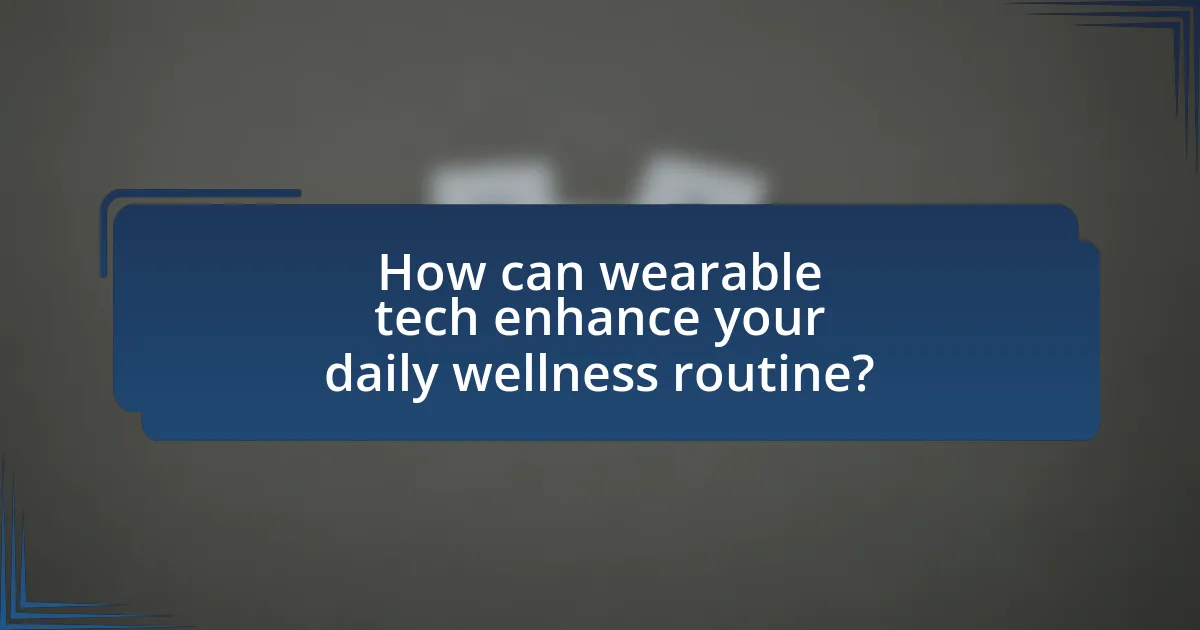The article focuses on how to effectively integrate wearable technology into daily wellness routines. It explores various types of wearable devices, including fitness trackers and smartwatches, and their roles in monitoring health metrics such as physical activity, heart rate, and sleep patterns. The content highlights the benefits of using wearable tech for real-time health insights, motivation, and accountability, while also addressing potential challenges like data privacy and user compliance. Additionally, it provides practical tips for selecting the right device, setting realistic wellness goals, and leveraging data to enhance overall health outcomes.

How can wearable tech enhance your daily wellness routine?
Wearable tech enhances daily wellness routines by providing real-time health monitoring and personalized feedback. Devices like fitness trackers and smartwatches can track metrics such as heart rate, sleep patterns, and physical activity levels, enabling users to make informed decisions about their health. For instance, a study published in the Journal of Medical Internet Research found that individuals using wearable devices increased their physical activity by an average of 30%. This data-driven approach helps users set achievable wellness goals and maintain motivation, ultimately leading to improved overall health outcomes.
What types of wearable tech are available for wellness tracking?
Wearable tech for wellness tracking includes fitness trackers, smartwatches, heart rate monitors, sleep trackers, and smart clothing. Fitness trackers, such as Fitbit and Garmin devices, monitor physical activity, steps, and calories burned. Smartwatches, like the Apple Watch, offer additional features such as notifications and health monitoring, including heart rate and ECG readings. Heart rate monitors, often used during exercise, provide real-time heart rate data to optimize workouts. Sleep trackers, integrated into many fitness devices or as standalone products, analyze sleep patterns to improve sleep quality. Smart clothing, equipped with sensors, can track various health metrics, including posture and muscle activity. These devices collectively contribute to a comprehensive approach to personal wellness management.
How do fitness trackers monitor physical activity?
Fitness trackers monitor physical activity primarily through sensors that detect movement and physiological data. These devices typically use accelerometers to measure motion in three dimensions, allowing them to track steps, distance traveled, and active minutes. Additionally, some fitness trackers incorporate heart rate monitors, which provide insights into the intensity of physical activity by measuring heart rate variability during exercise. Research indicates that accelerometers can accurately estimate energy expenditure and activity levels, making them reliable tools for monitoring fitness.
What role do smartwatches play in wellness management?
Smartwatches play a crucial role in wellness management by providing users with real-time health monitoring and personalized feedback. These devices track various health metrics such as heart rate, sleep patterns, physical activity, and stress levels, enabling users to make informed decisions about their wellness routines. For instance, a study published in the Journal of Medical Internet Research found that individuals using smartwatches for health tracking reported improved physical activity levels and better management of chronic conditions. This data-driven approach empowers users to set goals, monitor progress, and adjust their habits accordingly, ultimately enhancing their overall well-being.
How can health monitors track vital signs effectively?
Health monitors track vital signs effectively by utilizing advanced sensors and algorithms to measure parameters such as heart rate, blood pressure, and oxygen saturation. These devices often employ photoplethysmography (PPG) for heart rate monitoring, which detects blood volume changes in microvascular tissues, and electrocardiography (ECG) for more precise heart activity analysis. Additionally, many health monitors incorporate machine learning algorithms to analyze the collected data, providing real-time insights and alerts for abnormal readings. Studies have shown that wearable devices can achieve accuracy levels comparable to clinical measurements, enhancing their reliability for continuous health monitoring.
Why is integrating wearable tech important for wellness?
Integrating wearable tech is important for wellness because it enables individuals to monitor their health metrics in real-time, leading to informed lifestyle choices. Wearable devices, such as fitness trackers and smartwatches, provide data on physical activity, heart rate, sleep patterns, and stress levels, which can help users identify areas for improvement. Research indicates that users of wearable technology are more likely to engage in regular physical activity, with a study published in the Journal of Medical Internet Research showing a 30% increase in exercise frequency among participants using fitness trackers. This data-driven approach fosters accountability and motivation, ultimately enhancing overall well-being.
What are the psychological benefits of using wearable tech?
Wearable tech provides several psychological benefits, including enhanced motivation, improved mood, and increased self-awareness. These devices, such as fitness trackers and smartwatches, encourage users to set and achieve personal health goals, which can lead to a sense of accomplishment and boost self-esteem. Research indicates that individuals who use wearable technology report higher levels of physical activity, which is linked to improved mental health outcomes, such as reduced anxiety and depression. A study published in the Journal of Medical Internet Research found that users of wearable fitness devices experienced significant improvements in their overall well-being and mental health due to increased physical activity and self-monitoring.
How does wearable tech promote accountability in wellness routines?
Wearable tech promotes accountability in wellness routines by providing real-time data tracking and feedback on health metrics. This technology enables users to monitor their physical activity, sleep patterns, and vital signs, fostering a sense of responsibility towards their health goals. For instance, studies show that individuals who use fitness trackers are 30% more likely to meet their exercise goals compared to those who do not use such devices. Additionally, the social features of many wearable devices, such as sharing progress with friends or participating in challenges, further enhance motivation and accountability.
What challenges might arise when using wearable tech for wellness?
Challenges that might arise when using wearable tech for wellness include data privacy concerns, accuracy of health metrics, and user compliance. Data privacy issues stem from the collection and storage of sensitive health information, which can be vulnerable to breaches; a study by the Pew Research Center found that 60% of Americans are concerned about their personal data being collected by health apps. Accuracy of health metrics can vary significantly among devices, leading to potential misinformation about an individual’s health status; for instance, a review published in the Journal of Medical Internet Research highlighted discrepancies in heart rate monitoring across different wearables. User compliance is another challenge, as individuals may struggle to consistently wear the devices or engage with the data, which can diminish the effectiveness of the technology in promoting wellness; research from the American Journal of Preventive Medicine indicates that adherence rates for wearable devices can drop below 50% after six months.
How can users overcome data privacy concerns?
Users can overcome data privacy concerns by implementing strong security measures, such as using encryption and two-factor authentication. These practices protect personal data from unauthorized access and breaches. For instance, a study by the Ponemon Institute found that organizations using encryption experienced 60% fewer data breaches compared to those that did not. Additionally, users should regularly review privacy settings on their devices and applications to ensure they are sharing only necessary information. By taking these proactive steps, users can significantly enhance their data privacy while utilizing wearable technology.
What are common technical issues faced by wearable tech users?
Common technical issues faced by wearable tech users include connectivity problems, battery life limitations, and software glitches. Connectivity issues often arise due to poor Bluetooth or Wi-Fi signals, leading to difficulties in syncing data with smartphones or other devices. Battery life limitations can hinder the usability of wearables, as many devices require frequent charging, which can disrupt daily routines. Software glitches, such as app crashes or inaccurate data tracking, can also frustrate users, impacting the overall effectiveness of the wearable technology. These issues are frequently reported in user reviews and technical support forums, highlighting the need for manufacturers to address these challenges for improved user experience.

How can you effectively incorporate wearable tech into your daily routine?
To effectively incorporate wearable tech into your daily routine, start by setting specific health and fitness goals that align with your lifestyle. For instance, if you aim to increase your daily activity, use a fitness tracker to monitor steps and encourage movement throughout the day. Research shows that individuals who use wearable devices are 30% more likely to meet their fitness goals compared to those who do not. Additionally, integrate reminders and notifications from the device to prompt hydration, exercise, or mindfulness breaks, which can enhance overall well-being. By consistently utilizing the data and insights provided by wearable tech, you can make informed decisions that positively impact your health.
What steps should you take to start using wearable tech?
To start using wearable tech, first select a device that aligns with your health and fitness goals, such as a smartwatch or fitness tracker. Next, purchase the device from a reputable retailer, ensuring it has the features you need, like heart rate monitoring or GPS tracking. After acquiring the device, download the corresponding app on your smartphone to facilitate data synchronization and access additional features. Finally, familiarize yourself with the device’s functionalities through the user manual or online tutorials, enabling you to effectively integrate it into your daily wellness routine.
How do you choose the right device for your wellness goals?
To choose the right device for your wellness goals, first identify your specific health objectives, such as fitness tracking, stress management, or sleep improvement. Once your goals are clear, evaluate devices based on their features, compatibility with your lifestyle, and user reviews. For instance, a study published in the Journal of Medical Internet Research indicates that users who select devices aligned with their personal health objectives report higher satisfaction and better adherence to wellness routines. This evidence supports the importance of aligning device capabilities with individual wellness aspirations.
What features should you prioritize when selecting wearable tech?
When selecting wearable tech, prioritize features such as health monitoring capabilities, battery life, compatibility with other devices, and comfort. Health monitoring capabilities, including heart rate tracking, sleep analysis, and activity tracking, provide essential data for wellness routines. A long battery life ensures that the device remains functional throughout the day without frequent recharging, which is crucial for continuous health monitoring. Compatibility with smartphones and other devices allows for seamless integration into existing technology ecosystems, enhancing user experience. Lastly, comfort is vital, as a wearable device must be comfortable enough for daily use to encourage consistent wear and data collection.
How can you set realistic wellness goals with wearable tech?
To set realistic wellness goals with wearable tech, first assess your current health metrics using the device’s data, such as steps taken, heart rate, and sleep patterns. This initial evaluation provides a baseline from which to create achievable goals. For example, if your current average is 5,000 steps per day, a realistic goal might be to increase that to 6,000 steps over a month. Research indicates that gradual increases in activity levels are more sustainable; a study published in the Journal of Medical Internet Research found that users who set incremental goals were more likely to maintain their fitness routines. Additionally, regularly reviewing your progress through the wearable’s app can help adjust goals as needed, ensuring they remain attainable and motivating.
What strategies can help you track progress effectively?
To track progress effectively, utilize wearable technology that monitors key health metrics such as heart rate, steps taken, and sleep patterns. These devices provide real-time data, enabling users to set specific goals and receive immediate feedback on their performance. Research indicates that individuals who use wearables are 30% more likely to achieve their fitness goals compared to those who do not, as reported in a study by the American Journal of Preventive Medicine. By regularly reviewing this data, users can adjust their routines and maintain motivation, leading to improved overall wellness.
How can you adjust your goals based on data insights?
To adjust your goals based on data insights, analyze the metrics collected from wearable technology to identify trends and areas for improvement. For instance, if data shows a consistent lack of physical activity, set specific, measurable goals to increase daily steps or exercise frequency. Research indicates that individuals who utilize data from wearables are 30% more likely to achieve their fitness goals, as they can make informed adjustments based on real-time feedback. By regularly reviewing this data, you can refine your objectives to align with your progress and overall wellness aspirations.
What are best practices for maintaining motivation with wearable tech?
Best practices for maintaining motivation with wearable tech include setting specific, achievable goals, regularly tracking progress, and utilizing social features for accountability. Setting clear goals, such as daily step counts or workout durations, provides direction and purpose. Regularly tracking progress through the wearable device’s app allows users to visualize improvements, reinforcing motivation. Additionally, engaging with social features, such as sharing achievements or participating in challenges with friends, fosters a sense of community and accountability, which has been shown to enhance adherence to fitness routines.
How can social features enhance your experience with wearable tech?
Social features can significantly enhance your experience with wearable tech by fostering community engagement and motivation. When users can connect with friends or join groups, they often experience increased accountability and encouragement, which can lead to improved health outcomes. For instance, studies show that social interactions through fitness apps can boost user adherence to exercise routines by up to 30%. Additionally, sharing achievements and challenges with others can create a sense of belonging and competition, further driving user engagement and satisfaction with the technology.
What role does gamification play in sustaining engagement?
Gamification plays a crucial role in sustaining engagement by incorporating game-like elements into non-game contexts, which enhances user motivation and participation. This approach leverages rewards, challenges, and competition to create a more interactive experience, making activities more enjoyable and encouraging users to maintain consistent engagement over time. Research indicates that gamification can increase user retention rates by up to 30%, as seen in studies conducted by the University of Colorado, which found that users are more likely to stick with wellness programs that include gamified elements.

How can you maximize the benefits of wearable tech in your wellness journey?
To maximize the benefits of wearable tech in your wellness journey, consistently track and analyze your health metrics using the device’s features. Wearable technology, such as fitness trackers and smartwatches, provides real-time data on physical activity, heart rate, sleep patterns, and more, enabling users to make informed decisions about their health. Research indicates that individuals who actively engage with their wearable devices report improved motivation and adherence to fitness goals, as highlighted in a study published in the Journal of Medical Internet Research, which found that 70% of users experienced enhanced physical activity levels when utilizing wearable tech. By setting specific goals, regularly reviewing progress, and adjusting routines based on the insights gained from the data, users can effectively enhance their overall wellness journey.
What tips can help you integrate wearable tech seamlessly into your lifestyle?
To integrate wearable tech seamlessly into your lifestyle, start by selecting devices that align with your daily activities and health goals. For instance, if you aim to improve fitness, choose a smartwatch or fitness tracker that monitors heart rate and activity levels. Research shows that 60% of users report increased motivation to exercise when using wearable devices, indicating their effectiveness in promoting physical activity. Additionally, establish a routine for charging and syncing your device to ensure it remains functional and up-to-date. This consistency helps in maximizing the benefits of the technology, as regular data tracking can lead to better health insights and habits.
How can you create a daily routine that incorporates wearable tech?
To create a daily routine that incorporates wearable tech, start by selecting a wearable device that aligns with your health and fitness goals, such as a fitness tracker or smartwatch. Next, establish specific times during the day to engage with the device, such as checking your step count in the morning, monitoring heart rate during workouts, and reviewing sleep data at night. Research shows that consistent use of wearable tech can improve health outcomes; for instance, a study published in the Journal of Medical Internet Research found that individuals using fitness trackers increased their physical activity levels by an average of 30%. By integrating these practices into your daily schedule, you can effectively leverage wearable technology to enhance your wellness routine.
What are some common pitfalls to avoid when using wearable tech?
Common pitfalls to avoid when using wearable tech include neglecting data privacy, relying solely on the device for health insights, and failing to regularly update the software. Neglecting data privacy can lead to unauthorized access to personal health information, as many wearables collect sensitive data. Relying solely on the device for health insights may result in misinterpretation of data, as wearables are not substitutes for professional medical advice. Failing to regularly update the software can expose the device to security vulnerabilities and limit functionality, as manufacturers often release updates to improve performance and security.
How can you leverage data from wearable tech for better health outcomes?
You can leverage data from wearable tech for better health outcomes by analyzing metrics such as heart rate, sleep patterns, and physical activity levels to inform personalized health strategies. For instance, continuous heart rate monitoring can help identify abnormal patterns that may indicate health issues, allowing for timely medical intervention. Research shows that individuals who use wearable devices to track their physical activity are more likely to meet exercise recommendations, leading to improved cardiovascular health and weight management. A study published in the Journal of Medical Internet Research found that users of wearable fitness trackers increased their physical activity by an average of 30%. This data-driven approach enables users to make informed decisions about their health, ultimately leading to better health outcomes.
What insights can you gain from tracking your activity levels?
Tracking your activity levels provides insights into your physical health, fitness progress, and overall lifestyle habits. By monitoring metrics such as steps taken, calories burned, and active minutes, individuals can identify patterns in their daily routines that contribute to or hinder their wellness goals. For instance, a study published in the Journal of Medical Internet Research found that individuals who tracked their physical activity were more likely to increase their exercise levels by 30% compared to those who did not track their activity. This demonstrates that tracking can lead to improved motivation and accountability, ultimately enhancing one’s health outcomes.
How can you use health metrics to inform lifestyle changes?
Health metrics can be used to inform lifestyle changes by providing quantifiable data that highlights areas for improvement in physical well-being. For instance, tracking metrics such as heart rate, sleep patterns, and physical activity levels through wearable technology allows individuals to identify trends and make informed decisions about their health. Research indicates that individuals who monitor their health metrics are more likely to engage in regular exercise and maintain a balanced diet, leading to improved overall health outcomes. A study published in the Journal of Medical Internet Research found that users of wearable devices reported a 30% increase in physical activity levels after three months of tracking their metrics. This evidence supports the effectiveness of using health metrics to guide lifestyle modifications.
What are the future trends in wearable tech for wellness?
Future trends in wearable tech for wellness include advanced biometric monitoring, integration with artificial intelligence, and enhanced connectivity with smart home devices. Advanced biometric monitoring will enable wearables to track a wider range of health metrics, such as glucose levels and hydration status, providing users with comprehensive health insights. Integration with artificial intelligence will allow wearables to analyze data in real-time, offering personalized recommendations for fitness and wellness based on individual health patterns. Enhanced connectivity with smart home devices will facilitate a more holistic approach to wellness, allowing wearables to interact with home environments to optimize health-related settings, such as lighting and air quality. These trends are supported by the increasing demand for personalized health solutions and the growing capabilities of technology in health monitoring.
How is technology evolving to enhance user experience in wellness tracking?
Technology is evolving to enhance user experience in wellness tracking through advancements in wearable devices, artificial intelligence, and data integration. Wearable devices, such as smartwatches and fitness trackers, now offer real-time health monitoring, including heart rate, sleep patterns, and activity levels, which provide users with immediate feedback on their wellness. Artificial intelligence algorithms analyze this data to deliver personalized insights and recommendations, improving user engagement and motivation. Furthermore, seamless integration with mobile applications allows users to track their wellness journey holistically, consolidating data from various sources for a comprehensive view of their health. For instance, a study by the Journal of Medical Internet Research found that personalized feedback from wearable devices significantly increased user adherence to wellness goals, demonstrating the effectiveness of these technological advancements in enhancing user experience.
What innovations can we expect in wearable health monitoring devices?
Innovations in wearable health monitoring devices will include advanced biometric sensors, improved data analytics, and enhanced connectivity features. These devices are expected to integrate more sophisticated sensors capable of tracking a wider range of health metrics, such as glucose levels, hydration status, and even mental health indicators through physiological signals. For instance, research from the Journal of Medical Internet Research indicates that continuous glucose monitoring technology has significantly improved diabetes management, showcasing the potential for real-time health insights. Additionally, the incorporation of artificial intelligence will enable personalized health recommendations based on individual data patterns, enhancing user engagement and health outcomes. Enhanced connectivity through 5G technology will also allow for seamless data sharing with healthcare providers, facilitating timely interventions and remote monitoring.
What practical tips can help you troubleshoot common issues with wearable tech?
To troubleshoot common issues with wearable tech, first ensure that the device is charged and properly connected to its companion app. Many problems arise from low battery levels or connectivity issues, which can be resolved by charging the device or re-establishing the Bluetooth connection. Additionally, restarting the wearable can clear temporary glitches, while checking for software updates ensures that the device operates with the latest features and bug fixes. If the wearable is not tracking data accurately, recalibrating sensors or adjusting settings within the app can improve performance. Lastly, consulting the manufacturer’s support resources can provide specific troubleshooting steps tailored to the device model, enhancing the overall user experience.



